Mobile users, find MENU top left, LOGIN top right

Each year in California, more than 100 people are killed and hundreds of thousands more are injured in bicycle collisions. Some bicycle related crashes are connected to the bicyclist’s behavior, while others are due to the motorist’s lack of attention.
- Bicycle riders on public roads have the same rights and responsibilities as motorists, and are subject to the same rules and regulations.
- Motorists must look carefully for bicyclists before turning left or right, merging into bicycle lanes, and opening doors next to moving traffic. Respect the right-of-way of bicyclists because they are entitled to share the road with you.
Four Basic Safety Tips
Here are four basic bicycling tips:
- Maintain control of your bicycle.
- Protect yourself–reduce the risk of head injury by always wearing a helmet.
- Be visible, alert, and communicate your intentions.
- Ride with traffic.
Maintain Control of Your Bicycle
There are many things you can do to control your bicycle, even in an emergency. First, ensure your bicycle is the right size and properly adjusted to fit you. A properly fitted bicycle is easier to control, more comfortable, and causes less fatigue. A bicycle shop can help you choose the correct size bicycle. Ensure your bicycle is in good working order by inspecting it regularly.
The California Vehicle Code contains specific laws pertaining to bicycle riders. For example, it is unlawful to operate a bicycle while under the influence of an alcoholic beverage or a drug (CVC §21200.5).
Convictions are punishable by a fine. If you are under 21, but over 13 years of age, your driving privilege will be suspended or delayed for one year once you are eligible to drive.
Protect Yourself
Even a simple fall can cause a life threatening head injury. The brain is fragile and often does not heal the way that broken bones can. The damage can stay with you for life. Properly fitted helmets provide protection. By law, bicycle riders under 18 years of age must wear a bicycle helmet while riding on a public road (CVC §21212). Wear your helmet per manufacturer directions!
Wear your helmet per manufacturer directions.
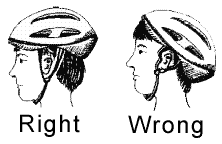
Be Visible and Alert
Even if you obey all traffic laws, there is always a risk of being hit by a motorist who is not obeying the laws, or who simply does not see you. Ride carefully–vehicles waiting at stop signs, in driveways, or parking spaces may suddenly pull out in front of you. Watch for vehicles that have just passed you and may turn right, as well as vehicles coming the opposite way that may turn left in front of you. Be prepared to stop or take evasive action.
Use hand signals before making turns or changing lanes to warn traffic around you. To signal a left turn, look behind you, over your left shoulder, and then extend your left arm out. To signal a right turn, hold your left arm up with your elbow bent (you may also hold your right arm straight and point to the right). You do not have to keep your arm extended while completing the maneuver always have at least one hand on the handlebars to maintain control. To signal that you are slowing or stopping, extend your left arm down.
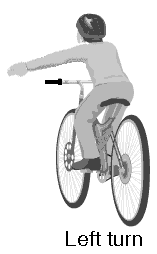
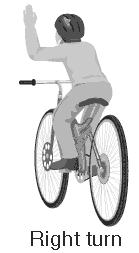
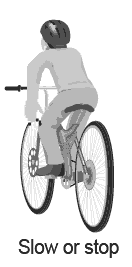
Using lights and reflectors at night is the law (CVC §21201). During darkness, bicyclists must have the following equipment:
- A front lamp emitting a white light visible from a distance of 300 feet.
- A rear red reflector visible from a distance of 500 feet.
- A white or yellow reflector on each pedal or on the bicyclist’s shoes or ankles visible from a distance of 200 feet.
- A brake which will enable the operator to make one braked wheel stop on dry, level, clean pavement.
Increase your visibility by wearing light or bright colored clothes, such as yellow or lime green. Red appears black in fading light and is not a good choice for riding in the evening. Mirrors provide opportunities for increased awareness of your surroundings, but use mirrors only as an aid. Always look over your shoulder to make sure the lane is clear before turning or changing lanes. Make sure your brakes are in good working order.
Ride With Traffic
Ride in the same direction as traffic. This will make you more visible to drivers entering roads or changing lanes, because they will know where to look for possible conflicts. On a one-way street, you may ride on the left as long as you are riding with traffic.
How Far to the Right?
Ride on the right, but not so far that you might hit the curb. You could lose your balance and fall into traffic. Do not ride too far to the right:
- When avoiding parked vehicles or road hazards.
- When a traffic lane is too narrow for a bicycle and vehicle to travel safely side by side.
- When making a left turn so that vehicles going straight do not collide into you.
- To avoid conflicts with right–turning vehicles.
Hazards
Keep your eyes on the road ahead. Avoid running over potholes, gravel, broken glass, drainage grates, puddles you can’t see through, or other unsafe road conditions. Look over your shoulder to avoid swerving suddenly into traffic. When possible, signal before changing lanes.
Parked Vehicles
Bicyclists should ride far enough away from parked vehicles to avoid being hit by an opening door.
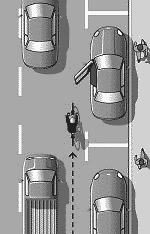
When to Take the Traffic Lane
A bicycle lane is a designated traffic lane for bicyclists, marked by a solid white line, typically breaking into a dotted line at the corner. Different from a simple white line showing the edge of the road, a bicycle lane follows specific width requirements and is clearly marked as a bike lane. Many roads do not have designated bicycle traffic lanes, so bicyclists will share the traffic lane to the left of the white line. If there is no shoulder or bicycle lane and the traffic lane is narrow, ride closer to the center of the lane. This will prevent motorists from passing you when there is not enough room. Bicyclists can travel at speeds of 20 mph, or faster. You should also use the traffic lane when you are traveling at the same speed as the traffic around you. This will keep you out of motorists’ blind spots and reduce conflicts with right-turning traffic.
Motorists Passing Bicyclists
Be patient when passing a bicyclist. Slow down and pass only when it is safe. Do not squeeze the bicyclist off the road. If road conditions and space permit, allow clearance of at least three feet when passing a bicyclist.
Obey Traffic Signs and Signals
Bicyclists must obey STOP signs and red signal lights. It’s a good idea to stop for yellow lights too–rushing through a yellow light may not leave you enough time to make it across the intersection before the light changes.
Left Turns
There are two proper methods for making a left turn on a bicycle:
1. Using Traffic Lanes
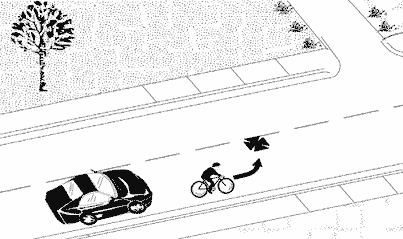
As you approach the intersection, look over your left shoulder for traffic. If clear, signal your turn and move over to the left side of the lane, or into the left or center turn lane. Position yourself so that vehicles going straight cannot pass you on your left while you are making your left hand turn. Yield to oncoming traffic before turning. If you are riding in a bicycle lane, or on a multilane road, you need to look and signal each time you change lanes. Never make a left turn from the right side of the road, even if you’re in a bicycle lane.
2. Using Crosswalks
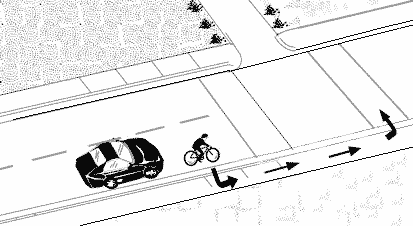
Approach the intersection staying on the right. Stop and either cross as a pedestrian in the crosswalk, or make a 90 degree left turn and proceed as if you were coming from the right. If there is a signal light, wait for the green or WALK signal before crossing. Yield to pedestrians in the crosswalk.
FFDL 37 (REV 6/2011)
